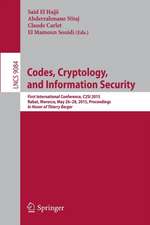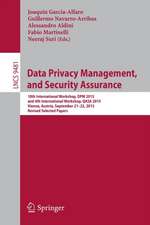Implementing Cryptography Using Python
Autor S Brayen Limba Engleză Paperback – 27 sep 2020
Preț: 239.80 lei
Preț vechi: 299.75 lei
-20% Nou
45.89€ • 49.83$ • 38.55£
Carte disponibilă
Livrare economică 01-15 aprilie
Specificații
ISBN-10: 1119612209
Pagini: 304
Dimensiuni: 185 x 242 x 17 mm
Greutate: 0.5 kg
Editura: Wiley
Locul publicării:Hoboken, United States
Notă biografică
SHANNON W. BRAY CASP, Security +, CISM is the Virtual CISO at Secured Systems providing clients guidance on establishing and maintaining information security plans, policies, procedures, standards, and guidelines using accepted frameworks. He has worked in this roles and others in corporations and federal agencies. Shannon has an MS in Cybersecurity from the University of Delaware. Prior to transitioning to cybersecurity, he was a well known IT expert with several successful books about Microsoft SharePoint.
Cuprins
Introduction xvii Chapter 1 Introduction to Cryptography and Python 1 Exploring Algorithms 2 Why Use Python? 2 Downloading and Installing Python 3 Installing on Ubuntu 4 Installing on macOS 4 Installing on Windows 4 Installing on a Chromebook 4 Installing Additional Packages 5 Installing Pip, NumPy, and Matplotlib 6 Installing the Cryptography Package 7 Installing Additional Packages 8 Testing Your Install 9 Diving into Python Basics 9 Using Variables 10 Using Strings 11 Introducing Operators 11 Understanding Arithmetic Operators 11 Understanding Comparison Operators 13 Understanding Logical Operators 13 Understanding Assignment Operators 14 Understanding Bitwise Operators 15 Understanding Membership Operators 15 Understanding Identity Operators 16 Using Conditionals 16 Using Loops 17 for 17 while 18 continue 18 break 18 else 18 Using Files 19 Understanding Python Semantics 20 Sequence Types 20 Introducing Custom Functions 26 Downloading Files Using Python 27 Introducing Python Modules 28 Creating a Reverse Cipher 29 Summary 30 Chapter 2 Cryptographic Protocols and Perfect Secrecy 31 The Study of Cryptology 32 Understanding Cryptography 32 Cryptography's Famous Family: Alice and Bob 33 Diffie-Hellman 34 Data Origin Authentication 34 Entity Authentication 35 Symmetric Algorithms 36 Asymmetric Algorithms 36 The Needham-Schroeder Protocols 36 The Otway-Rees Protocol 38 Kerberos 39 Multiple-Domain Kerberos 40 X.509 41 Formal Validation of Cryptographic Protocols 46 Configuring Your First Cryptographic Library 47 Understanding Cryptanalysis 47 Brute-Force Attacks 47 Side-Channel Attacks 48 Social Engineering 48 Analytical Attacks 48 Frequency Analysis 48 Attack Models 49 Shannon's Theorem 50 One-Time Pad 51 XOR, AND, and OR 51 One-Time Pad Function 56 One-Way Hashes 58 Cryptographic One-Way Hashes 59 Message Authentication Codes 60 Perfect Forward Secrecy 60 Published and Proprietary Encryption Algorithms 61 Summary 62 References 62 Chapter 3 Classical Cryptography 65 Password Best Practices 66 Password Storage 66 Hashing Passwords 67 Salting Passwords 67 Stretching Passwords 68 Password Tools 68 Obfuscating Data 69 ASCII Encoding 70 Base64 Encoding Text 70 Binary Data 72 Decoding 72 Historical Ciphers 72 Scytale of Sparta 73 Substitution Ciphers 73 Caesar Cipher 74 ROT-13 76 Atbash Cipher 77 Vigenère Cipher 77 Playfair 79 Hill 2x2 83 Column Transposition 87 Affine Cipher 90 Summary 93 Chapter 4 Cryptographic Math and Frequency Analysis 95 Modular Arithmetic and the Greatest Common Devisor 96 Prime Numbers 97 Prime Number Theorem 98 School Primality Test 98 Fermat's Little Theorem 100 Miller-Rabin Primality Test 100 Generate Large Prime Numbers 104 Basic Group Theory 106 Orders of Elements 107 Modular Inverses 109 Fermat's Little Theorem to Find the Inverse 110 Extending the GCD 111 Euler's Theorem 111 Pseudorandomness 115 Breaking C's rand() Function 116 Solving Systems of Linear Equations 117 Frequency Analysis 120 Cryptanalysis with Python 123 Using an Online Word List 125 Determining the Frequency 126 Breaking the Vigenère Cipher 129 Summary 138 Chapter 5 Stream Ciphers and Block Ciphers 139 Convert between Hexdigest and Plaintext 140 Use Stream Ciphers 141 ARC4 147 Vernam Cipher 148 Salsa20 Cipher 149 ChaCha Cipher 151 Use Block Ciphers 156 Block Modes of Operations 158 ECB Mode 158 CBC Mode 159 CFB Mode 160 OFB Mode 162 CTR Mode 163 Tricks with Stream Modes 164 DIY Block Cipher Using Feistel Networks 165 Advanced Encryption Standard (AES) 167 Using AES with Python 167 File Encryption Using AES 169 File Decryption Using AES 169 Summary 169 Chapter 6 Using Cryptography with Images 171 Simple Image Cryptography 171 Images and Cryptography Libraries 174 Understanding the Cryptography Library 174 Understanding the Cryptosteganography Library 175 Image Cryptography 175 File Cryptography Using Fernet 176 Image Cryptography Using Fernet 179 AES and Block Modes of Operations 180 Exploring a Simple ECB Mode Example 181 Exploring a Simple CBC Mode Example 185 Applying the Examples 186 Steganography 187 Storing a Message Inside an Image 188 Storing a Binary File Inside an Image 192 Working with large images 195 Summary 197 Chapter 7 Message Integrity 199 Message Authentication Codes 200 Hash-based Message Authentication Code 201 Using HMAC to Sign Message 202 Message Digest with SHA 203 Binary Digests 204 NIST Compliance 205 CBC-MAC 206 Birthday Attacks 207 Crafting Forgeries 209 The Length Extension Attack 209 Setting Up a Secure Channel 210 Communication Channels 211 Sending Secure Messages over IP Networks 212 Create a Server Socket 212 Create a Client Socket 213 Create a Threaded Server with TCP 214 Adding Symmetric Encryption 215 Concatenate Message and MAC 218 Summary 221 References 222 Chapter 8 Cryptographic Applications and PKI 223 The Public-Key Transformation 224 Exploring the Basics of RSA 226 Generating RSA Certificates 229 Constructing Simple Text Encryption and Decryption with RSA Certificates 231 Constructing BLOB Encryption and Decryption with RSA Certificates 232 The El-Gamal Cryptosystem 235 Elliptic Curve Cryptography 238 Generating ECC Keys 240 Key Lengths and Curves 241 Diffie-Hellman Key Exchange 242 Summary 245 Chapter 9 Mastering Cryptography Using Python 247 Constructing a Plaintext Communications Application 248 Creating a Server 248 Creating the Client 250 Creating the Helper File 251 Execution 252 Installing and Testing Wireshark 253 Implementing PKI in the Application Using RSA Certificates 255 Modifying the Server 256 Modifying the Client 257 Modifying the Helper File 258 Execution 259 Implementing Diffie-Hellman Key Exchange 261 Modifying the Server File 262 Modifying the Client File 264 Modifying the Helper File 266 Creating the Diffie-Hellman Class File 270 Execution 275 Wrapping Up 276 Index 277
Descriere
Learn to deploy proven cryptographic tools in your applications and services Cryptography is, quite simply, what makes security and privacy in the digital world possible. Tech professionals, including programmers, IT admins, and security analysts, need to understand how cryptography works to protect users, data, and assets. Implementing Cryptography Using Python will teach you the essentials, so you can apply proven cryptographic tools to secure your applications and systems. Because this book uses Python, an easily accessible language that has become one of the standards for cryptography implementation, you'll be able to quickly learn how to secure applications and data of all kinds. In this easy-to-read guide, well-known cybersecurity expert Shannon Bray walks you through creating secure communications in public channels using public-key cryptography. You'll also explore methods of authenticating messages to ensure that they haven't been tampered with in transit. Finally, you'll learn how to use digital signatures to let others verify the messages sent through your services. * Learn how to implement proven cryptographic tools, using easy-to-understand examples written in Python * Discover the history of cryptography and understand its critical importance in today's digital communication systems * Work through real-world examples to understand the pros and cons of various authentication methods * Protect your end-users and ensure that your applications and systems are using up-to-date cryptography






























